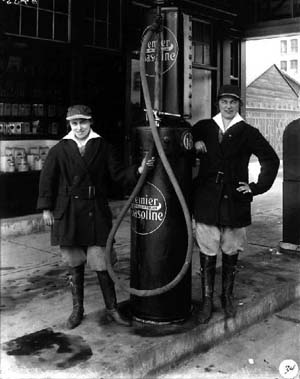Search | Image Archive | Reference | Communities | POV | Lesson Plans | Credits
 Almost immediately after 12,000 members of the Winnipeg Trades and Labour Council shut down the City of Winnipeg in a General Strike in 1919, the social and economics élites mobilized to regain control over the city.
Almost immediately after 12,000 members of the Winnipeg Trades and Labour Council shut down the City of Winnipeg in a General Strike in 1919, the social and economics élites mobilized to regain control over the city.
Winnipeggers who opposed the actions of the Unions banded together to form the Citizens' Committee of 1000, an organization which promised to return the city to ordinary operations through the use of volunteers who operated public utilities and other essential services.
The Committee did far more than just attempt to restore services. It was led by prominent business leaders and members of the Board of Trade, and it enjoyed the financial support of many of the city's businesses. Most of the members of the Committee opposed the unions on a matter of principle, and nearly all were economically damaged by the strike. The and the committee sought to portray the sympathetic strike as unnecessary, expensive, and a threat to private property.
The Committee published its own newspaper, the Citizen, to discredit the strikers and to provide a counter to the Bulletin of the Western Labour News, the official organ of the Trades and Labour Council. The Citizen invoked fear of communism as its chief weapon and tried to start a "Red Scare" by portraying the strike as a Bolshevik Revolution of the type that had gripped Russia only a year before. Although the leaders of the strike were primarily British in origin, the Committee painted them as "dangerous foreigners" and enemy aliens.
Many members of the Committee of 1000 wished to give no quarter when it came to the strikers, and they supported the swearing-in of hundreds of special constables to replace the police service, whose members were dismissed after they voted to join the strike. This confrontational attitude may be seen to have contributed to the tragic events of 21 June, Bloody Saturday, when the Specials were joined by the militia and the Northwest Mounted Police in dispersing the strikers.
Even at that point, with 27 injured and one dead, members of the Committee were reluctant to give quarter, and they opposed strongly a compromise between the strikers and Premier Norris which would have called-off the strike on the promise of a Royal Commission of Enquiry into the working conditions at Winnipeg enterprises. The Commission was granted and the strike concluded on 26 June.
The legacy of the Committee of 1000 lived on in the resolve of many of the city's business leaders never to allow the strike to be repeated and to prevent socialist control of municipal and provincial government.
Page revised: 29 August 2009